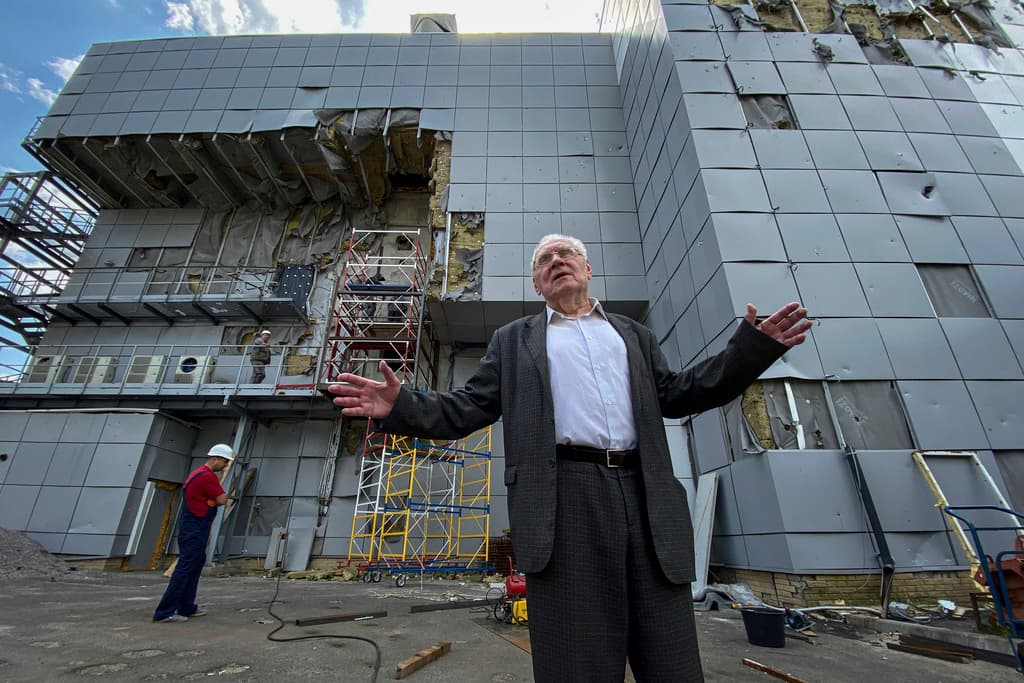Russian Strikes at Ukraine’s Experimental Nuclear Site Hint at Broader Battle
The International Atomic Energy Agency is accusing Moscow of ‘sustained targeting’ of a research lab.

The single comforting thing about the Chernobyl nuclear meltdown in 1986 is that it did not happen during a time of war. Since Russia mounted its full-scale invasion of Ukraine last year, the Zaporizhzhia nuclear power plant — the biggest one in Europe — has repeatedly been caught in the crossfire.
As Ukraine’s expected counteroffensive draws closer, so does the prospect of that plant having an unwelcome co-starring role, principally because Russia still occupies it. But other potential hot spots in Ukraine highlight the risk of the war expanding in unpredictable ways.
One such example is the Kharkiv Institute of Physics and Technology, an American-funded atomic research lab in northeastern Ukraine that according to the Associated Press has been struck by Russian rockets and bombs some 100 times during the first months of the war.
According to the AP, before Russia’s invasion, the institute was “a jewel in the crown of Ukraine’s highly developed nuclear research sector. Its experimental reactor had opened only six months earlier, designed to offer training and research facilities and to make medical isotopes used in cancer treatment.”
Although Ukraine successfully liberated Kharkiv from Russian forces months ago, the city is close to a major frontline and is still shelled regularly from the Russian region of Belgorod, right across the border.
The institute poses a multitude of predicaments. On the most elemental level, while it is emphatically not a nuclear power plant, it still houses fissile nuclear materials, and with repeated missile attacks comes a greater risk of leaks.
Russia has been accused of “sustained targeting” of the research lab by the International Atomic Energy Agency. After an agency visit to the lab in November, the IAEA chief, Rafael Mariano Grossi, said the extent of the damage was “shocking” and worse than expected.
On the first day of the war, the Kharkiv lab’s small reactor was provisionally deactivated. But if it is damaged severely enough, there could be bad consequences. The State Nuclear Regulatory Inspectorate of Ukraine has warned of potential “severe radiation consequences and contamination of the surrounding territories.”
Radiation would blow out as far as six miles in an area that is still home to 640,000 people. Radioactive pollution would likely spread north into Russian territory too.
The very existence of a nuclear research facility at Russia’s doorstep adds fuel to Russia’s fury that the West is “playing with fire,” as the foreign minister, Sergei Lavrov, has said. The cantankerous Russ was referring to Washington’s green light for the eventual delivery of F-16 fighter jets to Ukraine, but anything American-backed in Ukraine feeds the Russian narrative that the entire West is out to dismantle Russia, regardless of the situation in Ukraine.
When the Kharkiv facility started operating in August 2021, there was no way it could not have crossed the Kremlin’s radar. The AP reported that in its first iteration its role in developing nuclear weapons made it the Soviet equivalent of Los Alamos in America. Following the collapse of the Soviet Union in the early 1990s, Washington agreed to fund Ukrainian nuclear research in exchange for Ukraine getting rid of its stockpiles of nuclear bomb-making material.
Officials at Washington have said the Kharkiv nuclear lab, which was built in collaboration with the Argonne National Laboratory near Chicago, is the first of its kind in the world, “designed to produce medical isotopes, train nuclear professionals, support the Ukrainian nuclear industry and provide experimental capabilities for performing reactor physics, materials, and basic science research.”
Be that as it may, the proximity has predictably rankled the Russians, which is why they are hellbent on trying to destroy it.
The head of Russia’s security council, Nikolai Patrushev, has described the events in Ukraine as being the result of many years of American preparations for a hybrid war against Russia and an attempt to prevent the formation of a multipolar world. Between the American attempt to bolster Ukrainian scientific research and the general Russian effort to subdue its neighbors there is a gulf of miscommunication.
Whether that is failure of diplomacy or something else is difficult to ascertain, but when Mr. Lavrov says that Moscow and Washington are in a “hot phase of the war” because Ukrainians are fighting with American weapons, he is not altogether wrong. As Kori Schake wrote in the Atlantic, most Ukrainians understand that Ukraine would have already lost the war “without the support of the United States, which keeps its economy from collapsing, arming its soldiers and providing the necessary intelligence.”
All that too keeps the war on high heat. Adding to the flames are statements like the one from President Zelensky’s chief communications strategist, Mykhailo Podolyak, who on Monday called for a demilitarized zone of up to 75 miles to be established inside Russia along the Ukraine border as part of a post-war settlement.
Whether a sound suggestion or simply wish list material, for Moscow that is an inflammatory suggestion. As in all wars, gaps in communication can prove far more lethal than missiles.

